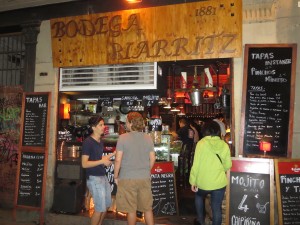We know we’ve said our farewells and that most of you have said goodbye in return, but can’t resist this one last post. Lagniappe is a favourite word we learnt on our first joint trip to the USA back in 1983. It comes from Louisiana French and refers to a little gift, usually given by a merchant to a buyer as in, says Wikipedia, a thirteenth donut. This post is our lagniappe to you – except that most of you are veteran travellers and know what we are going to say already. So, it is also a memento for us, a concatenation of the things we have learnt as travellers (from this and other trips) and would like to document for our own benefit. Here goes, in no particular order.
Eating and drinking

We’ve put eating and drinking first because it is one of the important parts of travel for us, not only because you have to eat to survive – duh! – but because it is such a significant part of experiencing other cultures. We love therefore to eat where and what the locals eat as much as possible. This means using sources like travel guides, online tourist sites like TripAdvisor, recommendations from locals such as your hotel/pension etc person, and following your own nose. It means avoiding those lovely big inviting squares, lined with restaurants and filled with people eating, drinking and apparently having a good time. These people are often mostly tourists, and the menus are usually big, glossy and full of pictures. Their prices are often higher and the food has often been modified for foreign tastes. It also means avoiding chains, particularly multinational ones.
Instead, go down the back alleys or, if in a big city, into the suburbs even. Look at the menus in the windows, look at who seems to be eating inside, and then go in. Occasionally you will be looked at askance, and even sometimes turned away because they think they won’t be able to provide what they think you want, but mostly you’ll be welcomed and you’ll have the best, most authentic experience. First, though, it’s good to research dining etiquette and tipping etc conventions. (Thank you internet for making this so much easier these days.) Some of the best experiences of our holidays come from dining – but that may just be us!
Sometimes, however, you are tired and desperate. If a big touristy restaurant in a square or a (preferably local!) chain is all that you can see in front of you, go for it. There will always be another meal!
Getting around or, using public transport

Where walking isn’t feasible, public transport – metros, buses, trams – is the cheapest, most efficient way of getting around (duh, again!). Working out how to pay and what the ticketing culture is can be tricky, but travel guides and information stands at the bigger transport points usually help. Besides getting you around, public transport, like dining, offers great opportunities for people watching and learning about the culture. Do people read, use their smart phones, bring their dogs on, sleep? What do they wear to work, to school? How do people – strangers, friends, lovers – relate to each other? What does the advertising on billboards etc tell you?
Do watch your pockets and purses though.
To audioguide or not to audioguide
We’ve not tended to be a big fan of the audioguide, partly because they can “direct” the way you think about an exhibition and partly because they can encourage you to only look at the highlights they pick. But, when visiting museums and other sites in non-English speaking countries, they are of immeasurable value, even in those places providing some English signage. In our recent trip, only once did we feel the tone and level pitched by the audioguide was a little irritating. Mostly, they were excellent.
You do though have to be technologically flexible. In our recent trip, the technology varied from iPods to small units with screens to large clunky units. Some had headphones/ear pieces while others had to be held up to the ear. Some (well, one that we experienced) were antenna controlled so they just started up when you reached the next point of interest, others required just entering a number or clicking the next/play arrow, while others required entering a number and clicking the play arrow. Some included optional extras – as in “if you’d like to hear more about the places where Beethoven lived, press the star key” – and some provided additional images on the unit’s screen (where it had one).
Cost varied too, from being included in the price to costing a few Euro. Some required a monetary deposit or the leaving of your passport or drivers licence for security.
Using travel guides
Travel guides – you know, Lonely Planet, Frommers, et al – are, we hear, in a spot of bother. More travellers are using online sources like TripAdvisor, Wiki, Triposo, and so on. For our recent overseas trips, we’ve used both. The “published” travel guide tends to be more authoritative than “social travel media”, though they have their biases. They also tend to be more oriented to our travel interests. (TripAdvisor “things to do”, for example, seem to include a lot of commercial tours.) But travel guides are dated before they even hit the stands and are pretty inflexible in terms of modern expectations.
We buy our travel guides in electronic version for our iPad/tablet, making them much lighter to carry. However, their functionality – in terms of searches, bookmarks, navigation and maps – is a little clunkier than we’d like, given the electronic environment. Mostly they appear to be electronic versions of the printed publication with minimal application of digital or interactive technology. All this might be improving, though, because travel guides themselves are starting to move online. We look forward to seeing what happens next.
Of course, travel guides are only one tool. The above-mentioned online services/sites, recommendations from friends, and of course tourist information offices in the places you visit are also valuable sources. There’s nothing like on-the-spot local knowledge.
To daypack or not to daypack
For this most recent trip, Sue carried a daypack (of the backpack/rucksack variety) while Len carried an over-the-shoulder bag. While Sue’s bag often met the size requirements, it was usually not allowed in museums and had to be put in a locker (most of which were free, requiring a coin deposit you got back). If this bothers you, think about what you use for carrying around your daily needs, like jacket, umbrellas, cameras. Occasionally, in large places, backpack style bags were allowed if worn on the front, but this isn’t always comfortable – and isn’t commonly allowed.
Doing the laundry
Isn’t laundry the bane of travel? It’s worth taking laundry needs into consideration when making accommodation arrangements we reckon. Using commercial laundrettes are best avoided if possible we reckon – though we did appreciate the Spanish ones that incorporated the laundry detergent in the machine. Put your clothes and money in, press start and go!
There’s a hotel chain in Japan that always provides guest laundry facilities. When in Japan we make sure we book those hotels every few days so that we know we can get clean again. Very few hotels/pensions in Europe (at least in the areas we’ve just visited) seemed to have guest laundries, but accommodation obtained through services like air bnb often will. Twice, we lucked out with washing being done for us at reasonable cost (ie not those horrendous hotel per-item charges) by the hotel/pension/guesthouse we were staying at. This is rare, but what a treat it is when it happens!
Travelling technologically
Hmmm … we should say something about this, but it is such a huge topic – and so dependent on whether you rely on smartphones, tablets, and/or laptops, and on whether your prime form of access is wi-fi or mobile/cellular – that we’ll leave it pretty much alone we reckon.
The lack of standardisation regarding access, the need for adapters and then for enough power points to recharge all those electronic items, not to mention the challenge of working out an efficient way of carrying the cables, chargers and adapters and knowing quickly which cable belongs to which device, are enough to try the most savvy traveller. At one hotel, as we were leaving, the friendly hotel keeper said “Have you left anything behind? We could start a shop for chargers here!” Oh dear!
Having a rest
Every trip we do, we tell ourselves we need to build in some rest days but somehow we never do. If anyone has any hints or advice or time-proven methods – besides organising more long train trips between towns – on how to lock in rest days, please let us know.

I nagged you a few times about rest days, didn’t I? Teehee! It’s fun to pretend to be the parent sometimes. 😉
I just learned the word “lagniappe” earlier this year. Love it. And you know I love that food comes first 😉 (though I’m enjoying the fact that food isn’t first in my life anymore, overall! 🙂 )
Snap, eh? It’s a great word isn’t it. And you’re right about food … it’s a top travel experience but it shouldn’t drive our lives. Glad you’ve got on top of that. 🙂